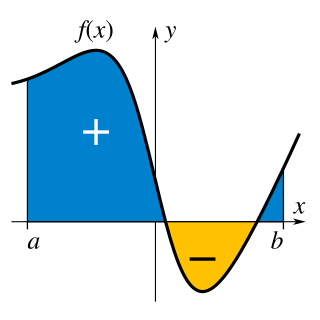Related Research Articles

In mathematics, convolution is a mathematical operation on two functions that produces a third function. The term convolution refers to both the result function and to the process of computing it. It is defined as the integral of the product of the two functions after one is reflected about the y-axis and shifted. The integral is evaluated for all values of shift, producing the convolution function. The choice of which function is reflected and shifted before the integral does not change the integral result. Graphically, it expresses how the 'shape' of one function is modified by the other.

G, or g, is the seventh letter in the Latin alphabet, used in the modern English alphabet, the alphabets of other western European languages and others worldwide. Its name in English is gee, plural gees.

In mathematics, an integral is the continuous analog of a sum, which is used to calculate areas, volumes, and their generalizations. Integration, the process of computing an integral, is one of the two fundamental operations of calculus, the other being differentiation. Integration started as a method to solve problems in mathematics and physics, such as finding the area under a curve, or determining displacement from velocity. Today integration is used in a wide variety of scientific fields.

In physics, the kinetic energy of an object is the form of energy that it possesses due to its motion.

The uncertainty principle, also known as Heisenberg's indeterminacy principle, is a fundamental concept in quantum mechanics. It states that there is a limit to the precision with which certain pairs of physical properties, such as position and momentum, can be simultaneously known. In other words, the more accurately one property is measured, the less accurately the other property can be known.

The lion is a large cat of the genus Panthera native to Africa and India. It has a muscular, broad-chested body; short, rounded head; round ears; and a hairy tuft at the end of its tail. It is sexually dimorphic; adult male lions are larger than females and have a prominent mane. It is a social species, forming groups called prides. A lion's pride consists of a few adult males, related females, and cubs. Groups of female lions usually hunt together, preying mostly on large ungulates. The lion is an apex and keystone predator; although some lions scavenge when opportunities occur and have been known to hunt humans, lions typically do not actively seek out and prey on humans.

In physics, engineering and mathematics, the Fourier transform (FT) is an integral transform that converts a function into a form that describes the frequencies present in the original function. The output of the transform is a complex-valued function of frequency. The term Fourier transform refers to both this complex-valued function and the mathematical operation. When a distinction needs to be made the Fourier transform is sometimes called the frequency domain representation of the original function. The Fourier transform is analogous to decomposing the sound of a musical chord into the intensities of its constituent pitches.

In mathematics, a function from a set X to a set Y assigns to each element of X exactly one element of Y. The set X is called the domain of the function and the set Y is called the codomain of the function.

In thermodynamics, the Gibbs free energy is a thermodynamic potential that can be used to calculate the maximum amount of work, other than pressure-volume work, that may be performed by a thermodynamically closed system at constant temperature and pressure. It also provides a necessary condition for processes such as chemical reactions that may occur under these conditions. The Gibbs free energy is expressed as

Kenneth Bruce Gorelick, known professionally as Kenny G, is an American smooth jazz saxophonist, composer, and producer. His 1986 album Duotones brought him commercial success. Kenny G is one of the best-selling artists of all time, with global sales totaling more than 75 million records.
Indotyphlops pammeces, the South India worm snake, is a harmless blind snake species found in southern India. No subspecies are currently recognized.
Stictoptera is a genus of moths of the family Euteliidae erected by Achille Guenée in 1852.
Pammeces is a genus of moths in the family Agonoxenidae. It was formerly included in the Cosmopterigidae.
Pammeces pallida is a moth of the family Agonoxenidae. It was described by Thomas de Grey, 6th Baron Walsingham, in 1897. It is found in the West Indies.
Pammeces phlogophora is a moth of the family Agonoxenidae. It was described by Walsingham in 1909. It is found in Panama.
Pammeces problema is a moth of the family Agonoxenidae. It was described by Walsingham in 1915. It is found in Colombia.
Pammeces citraula is a moth of the family Agonoxenidae. It was described by Edward Meyrick in 1922. It is found in Peru.
Pammeces albivittella is a moth of the family Agonoxenidae. It was described by Philipp Christoph Zeller in 1863. It is found in Venezuela.
Labdia pammeces is a moth in the family Cosmopterigidae. It is found in Australia, where it has been recorded from Queensland.
References
- ↑ Beccaloni, G.; Scoble, M.; Kitching, I.; Simonsen, T.; Robinson, G.; Pitkin, B.; Hine, A.; Lyal, C., eds. (2003). "Pammeces crocoxysta". The Global Lepidoptera Names Index . Natural History Museum . Retrieved May 11, 2018.